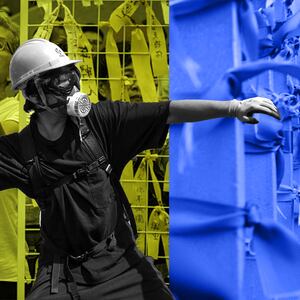A traffic police officer in Hong Kong shot an unarmed 21-year-old pro-democracy protester at point-blank range on Monday. Hours later, a man was set on fire after defending Beijing in an argument. Both individuals were listed in critical condition.
Over the weekend, wide-scale disturbances scarred the territory, a semi-autonomous region of the People’s Republic of China. There is essentially a rebellion in Hong Kong. Riot police in green uniforms are doing battle with youthful demonstrators dressed in black.
Protests began in April after Chief Executive Carrie Lam, Hong Kong’s top official, proposed legislation authorizing the extradition of fugitives to various jurisdictions, including Mainland China. Starting June 9, when an estimated one million Hong Kongers marched in the streets, demonstrations have been almost continuous. Lam has since permanently withdrawn the extradition bill from consideration, but the protests have not abated.
Especially this week. Hong Kong braced for a weekend of disturbances after Chow Tsz-lok, a 22-year-old student at the Hong Kong University of Science and Technology, died on Friday after falling from a car park the preceding Sunday while running away from police tear gas. Many have accused the police of delaying medical assistance to the mortally injured Chow.
Chow has been called “the first fatality linked to police action during a protest,” but many believe the police have killed others. Demonstrators believe three of their number were beaten to death on August 31 in the Prince Edward Mass Transit Railway station in Mong Kok.
Since then, the above-ground entrance to the station has become a shrine, protestors have repeatedly rallied in front of the adjacent Mong Kok police station, and youth have continually trashed MTR trains and stations because they believe management of the rail system has withheld surveillance-camera footage.
Even a single death creates a cycle of revenge and retaliation that is almost impossible to control. Chow’s passing sparked a weekend of rage.
Moreover, Chief Executive Lam added to the tensions. In her most recent press conference, held Monday after the shooting and burning incidents, she called protesters the “enemy of the people.” Her provocative Cultural Revolution-speak comment came on the heels of her November 4 meeting with Chinese ruler Xi Jinping. China is apparently controlling events, and either out of obliviousness or maliciousness, it is making the situation worse.
Beijing has been doing that by forcing Lam to take a hard line. Apart from the withdrawal of the extradition bill—doomed because the normally pro-Beijing business community came out against it early on—she has been intransigent.
That intransigence was evident from her Monday remarks. She said she would not yield to violence, but she had previously left Hong Kong people no choice. She had, with her stubbornness, earlier foreclosed the possibility of peaceful change.
Hong Kong people may not be able to change her mind, but she cannot change theirs either. The army in black—as well as many other people in the territory—have continued to protest.
Analysts say Beijing will eventually lose patience and use force. “This kind of extreme, violent, and destructive activity would not be tolerated or accepted in any country or society in the world nowadays,” said Chinese Vice-Premier Han Zheng as he met with Lam early this month in Beijing.
Han’s words were taken as a threat to formally deploy units of the People’s Liberation Army or the People’s Armed Police to the streets of Hong Kong to “crush” the protests and reestablish order.
Beijing could move in troops, but the move is unlikely to work. Hong Kong, after all, is ideal territory for defenders, like guerilla fighters supported by an overwhelming portion of the public. Every apartment building there is a fort where hostiles can rain down explosives or petrol bombs on Chinese troops and then disappear into their homes or back alleys. Xi Jinping surely does not want his first war to take tens of thousands of soldiers, last years if not decades, and end in a loss for China.
In the meantime, there is credible evidence suggesting Mainland Chinese personnel—troops or police—are now operating on Hong Kong streets in police uniforms. This sly tactic is not working, however.
Why not? The Hong Kong police department, once considered the most professional force of its kind in Asia, has lost discipline, something evident from the shooting of the protester Monday and countless other incidents. The breakdown in discipline roughly coincides with early evidence that Chinese forces were mixed in with the Hong Kong police, and the resulting rough tactics have resulted in a loss of support of ordinary residents tired of being tear gassed, clubbed, and manhandled.
All this raises the question whether Beijing has given the green light to police officers to act as brutally as they want. Yet whether China did so or not, harsh action by the police is sustaining support for the protesters.
Demonstrators this past weekend were chanting “Revenge.” Hong Kong is now at war with itself. There is no end in sight to the fighting.








